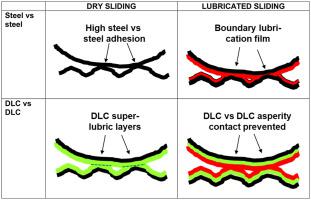Wear ( IF 5.3 ) Pub Date : 2021-09-09 , DOI: 10.1016/j.wear.2021.204093 K. Holmberg 1 , A. Laukkanen 1 , T. Hakala 1 , H. Ronkainen 1 , T. Suhonen 1 , M. Wolski 2 , P. Podsiadlo 2 , T. Woloszynski 2 , G. Stachowiak 2 , C. Gachot 3 , L. Li 4

|
Surface topography can affect the tribological performance in many applications. The influence of surface roughness and topographic orientation on friction and wear in dry and oil lubricated steel vs steel and diamond-like carbon (DLC) coated steel vs DLC coated steel sliding contacts was investigated. The surfaces had a centerline average roughness (Ra) between 0.004 and 0.11 μm and a topographic groove orientation of 0°, 45° and 90° with respect to the sliding direction. Tests conducted showed that the strongest effect of the orientation of the topographic directions occurs in dry sliding DLC vs DLC contacts. A super-lubricious DLC surface layer was efficiently formed, exhibiting low friction coefficients of 0.04 for smooth surfaces, and rough surfaces with grooves oriented along the sliding direction. The process of surface layer formation was most severely disturbed for average surfaces roughness with grooves oriented at 45° to the sliding direction. For these surfaces, the coefficient of friction was about five times higher (0.21) as compared to smooth samples (0.04). In dry sliding steel contacts, the coefficient of friction decreased with increasing surface roughness. On the other hand, the coefficient of friction increased with surface roughness in oil lubricated steel contacts. Adding a synthetic oil into the DLC vs DLC sliding contact prevented the formation of the super-lubricious surface layer. In tests with rotational steel vs steel sliding the friction coefficient was about 10% lower than in test with linear reciprocal sliding but was higher in DLC vs DLC contacts.
中文翻译:

地形取向对滑动 DLC 和钢接触中摩擦和磨损的影响,第 3 部分:干燥和润滑条件下的实验
在许多应用中,表面形貌会影响摩擦学性能。研究了表面粗糙度和形貌取向对干润滑和油润滑钢与钢以及类金刚石碳 (DLC) 涂层钢与 DLC 涂层钢滑动接触摩擦和磨损的影响。表面具有中心线平均粗糙度(R a) 介于 0.004 和 0.11 μm 之间,并且相对于滑动方向的地形凹槽方向为 0°、45° 和 90°。进行的测试表明,在干滑动 DLC 与 DLC 接触中,地形方向的取向影响最强。高效地形成了超润滑的 DLC 表面层,对于光滑表面和带有沿滑动方向取向的凹槽的粗糙表面,其摩擦系数为 0.04。表面层形成过程受到平均表面粗糙度的最严重干扰,凹槽与滑动方向成 45°。对于这些表面,与光滑样品 (0.04) 相比,摩擦系数 (0.21) 大约高出五倍。在干滑动钢接触中,摩擦系数随着表面粗糙度的增加而降低。另一方面,油润滑钢接触的摩擦系数随着表面粗糙度的增加而增加。在 DLC 与 DLC 滑动接触中添加合成油可防止形成超润滑表面层。在使用旋转钢与钢滑动的测试中,摩擦系数比使用线性往复滑动的测试低约 10%,但在 DLC 与 DLC 接触中更高。









































 京公网安备 11010802027423号
京公网安备 11010802027423号